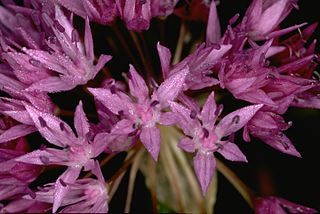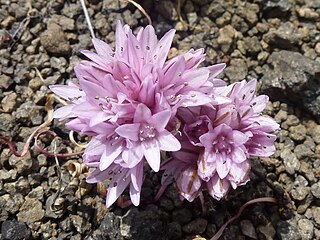
Allium validum is a species of flowering plant commonly called swamp onion, wild onion, Pacific onion, or Pacific mountain onion. It is native to the Cascade Range, to the Sierra Nevada, the Rocky Mountains, and other high-elevation regions in California, Oregon, Washington, Nevada, Idaho and British Columbia. It is a perennial herb and grows in swampy meadows at medium and high elevations.

Allium cernuum, known as nodding onion or lady's leek, is a perennial plant in the genus Allium. It grows in open areas in North America.

Allium textile is a common species of wild onion found in the central part of North America.

Allium acuminatum, also known as the tapertip onion or Hooker's onion, is a species in the genus Allium native to North America.

Allium atrorubens is a species of wild onion known by the common name dark red onion. This plant is native to the southwestern United States where it grows in the sandy soils of the Mojave Desert, the Great Basin and higher-elevation deserts in Nevada, eastern California southwestern Utah, northwestern Arizona.

Allium lemmonii is a species of wild onion known by the common name Lemmon's onion, named for botanist John Gill Lemmon (1831–1908). It is native to the western United States, at elevations of 1200–1900 m in the Great Basin of Utah, Nevada, northern and eastern California, eastern Oregon, southwestern Idaho.

Allium nevadense is a species of wild onion known by the common name Nevada onion. It is native to the western United States where it grows in sand and rocky soil at elevations of 1400–1700 m. The species is widespread in Utah, Nevada and southern Idaho, and has been reported also from southeastern California, northwestern Arizona, western and central Colorado and eastern Oregon.

Allium parvum is an American species of wild onion known by the common name small onion. It is native to the western United States where it is a common member of the flora in rocky, dry areas in mountainous areas, especially in talus at elevations of 1,200–2,800 m (3,900–9,200 ft). It is widespread in California, Nevada, Oregon and Idaho, and also reported from western Utah and from extreme southwestern Montana
Allium punctum is a species of wild onion known by the common name dotted onion or Modoc onion. It is native to the western United States in and around the Modoc Plateau in northeastern California, northwestern Nevada, and southeastern Oregon. It is uncommon, growing in volcanic flatlands created by old lava flows.

Aquilegia grahamii is a species of flowering plant in the buttercup family known by the common name Graham's columbine. It is endemic to Utah in the United States, where it is known only from Uintah County. It occurs in three canyons along the Uinta Mountains. There are an estimated 5,000 to 10,000 individuals.
Phacelia cronquistiana is a plant species native to Utah and Arizona, known only from Kane and Mohave Counties. It occurs in sagebrush and Pinus ponderosa forests at elevations of 1,900–2,100 m (6,200–6,900 ft).
Penstemon franklinii, or Franklin's penstemon, is a plant species endemic to Utah, United States, known only from Cedar Valley in Iron County. It grows in grasslands and in sagebrush communities.

Allium aaseae, the Southern Idaho onion or Aase's onion, is a plant species endemic to southwestern Idaho. It has been reported from 6 counties: Elmore, Ada, Boise, Gem, Payette and Washington.

Allium brandegeei is a plant species native to the western United States. It has been reported from western Colorado, Utah, Idaho, eastern Oregon, Park County, Montana and Elko County, Nevada.

Allium macropetalum, the desert onion, is a species of wild onion native to the desert regions of southwestern United States and northwestern Mexico. It is known from desert plains and hills in Sonora, Arizona, Utah, Colorado, New Mexico, and Texas, at elevations up to 2500 m.
Allium passeyi is a plant species endemic to Box Elder County in northwestern Utah. It grows in shallow, stony locations at elevations of 1400–1600 m.

Allium robinsonii, the Columbia River onion or Robinson's onion, is a rare plant species native to the US States of Washington and Oregon, although some studies suggest that the Oregon populations may now be extinct. The species has been reported from five counties in Washington and five in Oregon. It is found in sand and gravel deposits along the lower Columbia River and some of its tributaries, usually at elevations less than 200 m. The species is also cultivated as an ornamental in other regions, including in Europe.

Allium simillimum, the Simil Onion, or dwarf onion, is a plant species native to Idaho and Montana. It grows on sandy soils at high elevations in the mountains, 1800–3400 m.

Allium tolmiei is a plant species native to Idaho, eastern and central Oregon, southeastern Washington, northwestern Nevada and northeastern California. It occurs on mountains and scrublands at elevations of 1,300–9,200 feet (400–2,800 m). It was discovered by and named for Dr. William Fraser Tolmie.

Allium brevistylum is a plant species native to the western United States. It grows in meadows and along stream banks high in the mountains of Colorado, Utah, Wyoming, Montana and Idaho, at elevations of 2200–3400 m.

















